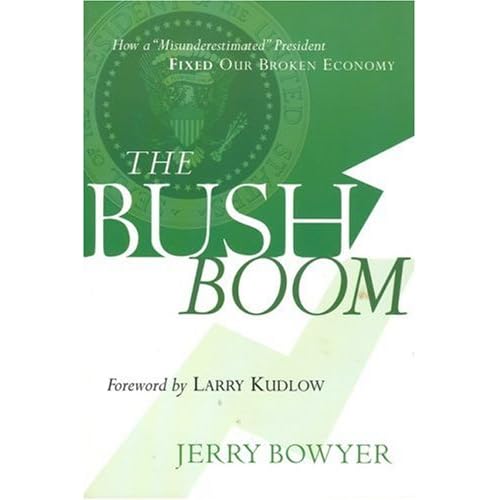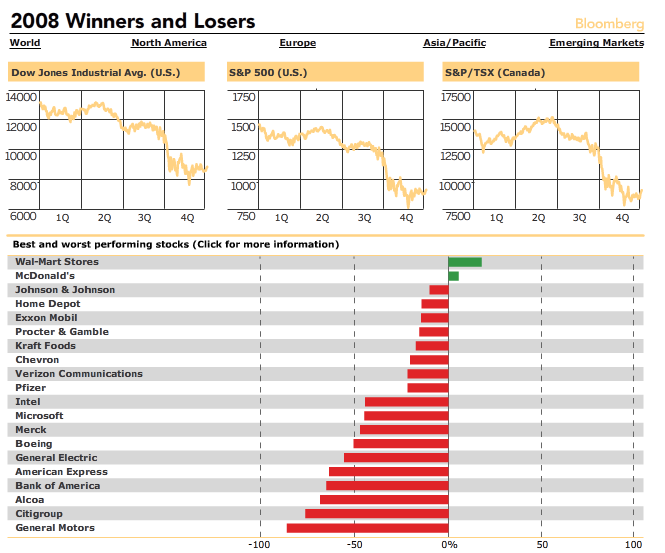While it is roughly 1½ days left of the Bush presidency, and much longer time until all the data is available, I still don't think it is not too early to give a preliminary assessment of the Bush presidency. I will here focus on the economic aspects.
Assuming a 1.3% decline (5% decline at an annual rate) in Q4 2008,
the economy grew 16.9% between Q4 2000 and Q4 2008, which is less than 2% at an annual rate. The equivalent number for the Clinton presidency was 3.6%, for papa Bush's presidency 2.1% and for Reagan's presidency 3.5%. Thus, the economy performed even worse than when his father was president, and much worse than during the Reagan's and Clinton's presidencies. If you adjust for population growth, these annual numbers are about 1 percentage point lower.
As was noted before, industrial production fared even worse, being virtually unchanged. The entire increase in GDP came in services, with government services increasing particularly fast, as
the share of GDP going to government purchases rose to 17.6% in Q4 2000 to 20.4% in Q3 2008 (Some of that probably went into manufacturing of for example fighter aircrafts and other military equipment, but that only makes manufacturing of private products look even worse). The Q4 2008 numbers aren't ready yet, but considering the rapid decline in private sector output in that quarter and the spending increases suggested by
the budget numbers, it will probably land at slightly below 21%.
This weakness is also reflected upon in
the labor market, as unemployment rose from 3.9% to 7.2% even as the labor force participation rate fell from 67% to 65.7%. As a result, the employment to population ratio fell from 64.4% to 61%. While 5.7 million new jobs were created according to the household survey, that was nowhere enough given the increase in population.

Not that much of a "Bush boom" in other words. Now, to be fair, it would be wrong to blame Bush for the dismal performance during his presidency. He inherited an economy that was falling into a recession because of the tech stock bubble, and while the housing bubble in 2001-2006 did provide a limited boost, it also dragged down the economy in 2007 and 2008. By contrast, Clinton was really lucky to inherit an economy that was just recovering from recession and then enjoyed the pleasant phase of the tech stock bubble while leaving office just before the bust was apparent in growth statistics.
The main blunder of Bush was to reappoint
the man guilty for the current problems, Alan Greenspan as Fed chairman, but then again that was a mistake also made by Reagan, papa Bush and Clinton. He also increased spending far too much (more on that below) and
implemented policies that in the name of his "ownership society" vision aggravated the housing bubble. He did however also pursue some good policies, mainly the 2003 tax cuts, which did in fact create a lot of sound growth, particularly in 2003 and 2004.
When it comes to
the budget, the most striking thing is the how much the budget balance weakened. In fiscal year 2000, the budget had a surplus of 2.4% of GDP whereas in fiscal 2008 it had a deficit of 3.2%. While that was below the post-World War II record of 6.0% in 1983, Reagan had inherited a large deficit from Carter and by the end of his term, the deficit was only slightly above where it started.
This reflected both a decline in tax revenues and a surge in spending. Revenues fell from 20.9% of GDP to 17.7%. This reflects in part how revenues in 2000 was inflated because of capital gains tax revenues from the inflated stock market and in part it reflect the active tax cut decisions made by Bush.
Spending at the same time rose from 18.4% of GDP to 20.9%. This increase is even worse if you consider that because of lower interest rates, interest payments fell from 2.3% to 1.7%. Excluding interest payments, spending rose from 16.1% to 19.2%, the most dramatic increase since World War II. To some extent Bush can blame this on cyclical factors, but he certainly shares a great deal of responsibility for this as he actively initiated several new spending programs, including the "No Child Left Behind" act, the Medicare drug benefit bill and of course the Iraq war. Also, during his first 6 years in office he only vetoed 1 spending bill from Congress, and that was a relatively minor one and also done for the wrong reason (I'm talking about
funding of stem cell research).
After the Democrats won the 2006 congressional election, he did seem to improve. He proposed no new spending bills and started to veto several spending bills passed by the Democrats. However, once the financial crisis made a turn for the worse, so did Bush, who pushed for and implemented massive bailouts of Wall Street financial companies and Detroit car companies.
To summarize, while Bush has done a few good things, most notably his relative skepticism to the "global warming"-hysteria, the 2003 tax cuts and a few spending vetoes in his last few years, the overall assessment is very negative given his support for Greenspan, the massive increase in spending and the bailouts. Not surprisingly given how bad the policies were, the economic performance was also very weak. Because of those failures, he paved the way for the incoming Obama administration, who will continue and increase the dose of Bush's more destructive sides.



